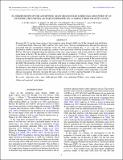| dc.contributor.author | Libert, Y. | |
| dc.contributor.author | Gerard, E. | |
| dc.contributor.author | Le Bertre, T. | |
| dc.contributor.author | Johnson, M. C. | |
| dc.contributor.author | Dame, T. M. | |
| dc.contributor.author | Matthews, Lynn D. | |
| dc.date.accessioned | 2015-01-15T16:22:11Z | |
| dc.date.available | 2015-01-15T16:22:11Z | |
| dc.date.issued | 2011-01 | |
| dc.date.submitted | 2010-07 | |
| dc.identifier.issn | 0004-6256 | |
| dc.identifier.issn | 1538-3881 | |
| dc.identifier.uri | http://hdl.handle.net/1721.1/92879 | |
| dc.description.abstract | We report H I 21 cm line observations of the asymptotic giant branch (AGB) star X Her obtained with the Robert C. Byrd Green Bank Telescope (GBT) and the Very Large Array. We have unambiguously detected H I emission associated with the circumstellar envelope of the star, with a mass totaling M[subscript H I] ≈ 2.1 × 10[superscript –3] M[subscript ☉]. The H I distribution exhibits a head-tail morphology, similar to those previously observed around the AGB stars Mira and RS Cnc. The tail is elongated along the direction of the star's space motion, with a total extent of [> over ~] 6.'0 (0.24 pc) in the plane of the sky. We also detect a systematic radial velocity gradient of ~6.5 km s[superscript –1] across the H I envelope. These results are consistent with the H I emission tracing a turbulent wake that arises from the motion of a mass-losing star through the interstellar medium (ISM). GBT mapping of a 2° × 2° region around X Her reveals that the star lies (in projection) near the periphery of a much larger H I cloud that also exhibits signatures of interaction with the ISM. The properties of the cloud are consistent with those of compact high-velocity clouds. Using [superscript 12]CO J = 1-0 observations, we have placed an upper limit on its molecular gas content of N[subscript H2] < 1.3 × 10[superscript 20] cm[superscript –2]. Although the distance to the cloud is poorly constrained, the probability of a chance coincidence in position, velocity, and apparent position angle of space motion between X Her and the cloud is extremely small, suggesting a possible physical association. However, the large H I mass of the cloud ([> over ~] 2.4 M[subscript ☉]) and the blueshift of its mean velocity relative to X Her are inconsistent with an origin tied directly to ejection from the star. | en_US |
| dc.description.sponsorship | National Science Foundation (U.S.). Research Experience for Undergraduates (Program) | en_US |
| dc.language.iso | en_US | |
| dc.publisher | IOP Publishing | en_US |
| dc.relation.isversionof | http://dx.doi.org/10.1088/0004-6256/141/2/60 | en_US |
| dc.rights | Article is made available in accordance with the publisher's policy and may be subject to US copyright law. Please refer to the publisher's site for terms of use. | en_US |
| dc.source | American Astronomical Society | en_US |
| dc.title | H I observations of the asymptotic giant branch star X Herculis: Discovery of an extended circumstellar wake superposed on a compact high-velocity cloud | en_US |
| dc.type | Article | en_US |
| dc.identifier.citation | Matthews, L. D., Y. Libert, E. Gerard, T. Le Bertre, M. C. Johnson, and T. M. Dame. “H I Observations of the Asymptotic Giant Branch Star X Herculis: Discovery of an Extended Circumstellar Wake Superposed on a Compact High-Velocity Cloud.” The Astronomical Journal 141, no. 2 (January 13, 2011): 60. © 2011 The American Astronomical Society | en_US |
| dc.contributor.department | Haystack Observatory | en_US |
| dc.contributor.mitauthor | Johnson, M. C. | en_US |
| dc.contributor.mitauthor | Matthews, Lynn D. | en_US |
| dc.relation.journal | Astronomical Journal | en_US |
| dc.eprint.version | Final published version | en_US |
| dc.type.uri | http://purl.org/eprint/type/JournalArticle | en_US |
| eprint.status | http://purl.org/eprint/status/PeerReviewed | en_US |
| dspace.orderedauthors | Matthews, L. D.; Libert, Y.; Gerard, E.; Le Bertre, T.; Johnson, M. C.; Dame, T. M. | en_US |
| mit.license | PUBLISHER_POLICY | en_US |
| mit.metadata.status | Complete | |
